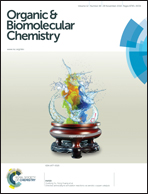Pseudo-cyclic structures of mono- and di-azaderivatives of malondialdehydes. Synthesis and conformational disentanglement by computational analyses†
Abstract
Mono- and diaza-derivatives of malondialdehydes, namely 3-alkyl(aryl)amino-2-arylacroleins and 1,5-dialkyl(aryl)-3-arylvinamidines are open-chain systems in which extended electron delocalization and pseudoaromaticity can be envisaged. A set of diversely functionalized compounds has been synthesized and characterized by spectroscopic data and X-ray diffractometry. Quantum-chemical calculations were performed for all possible neutral tautomers and conformers in the gas phase and compared to those in polar solvents (CHCl3, DMSO, and EtOH) at the M06-2X/6-311++G(d,p) level. Tautomeric equilibria and conformational preferences can be rationalized in terms of structural factors, which can be roughly estimated as summation or subtractions of intramolecular interactions. As expected, a key role is played by intramolecular hydrogen bonds whose strength varies from the gas phase to polar ethanol. This issue also delves into the concept of resonance-assisted H-bond, where the donor and acceptor atoms are connected by a π-conjugated system. The most stable conformers (structures a and c) possess a high degree of pseudoaromaticity as inferred from HOMA indexes and other delocalization parameters.


 Please wait while we load your content...
Please wait while we load your content...